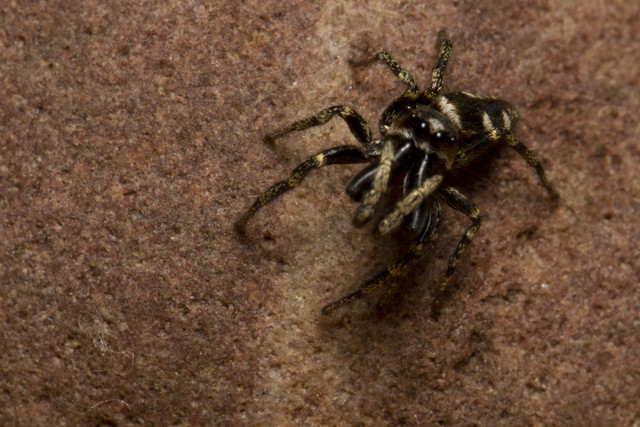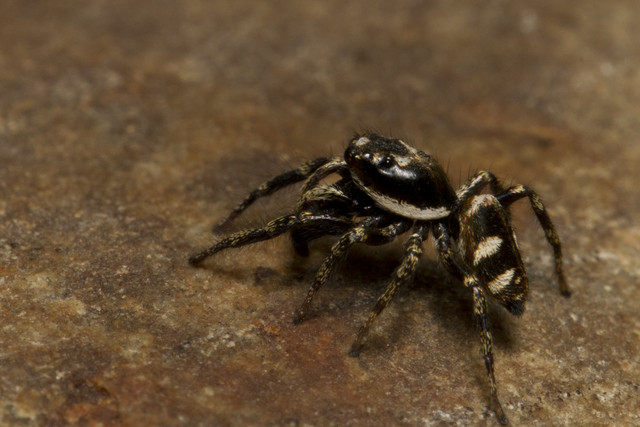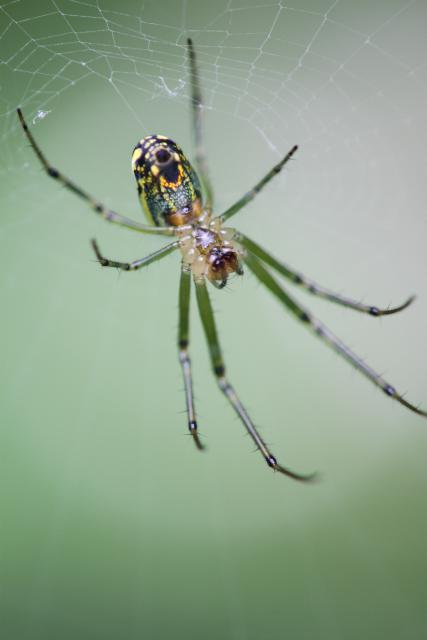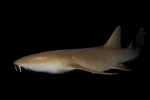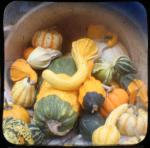spider
Warning: Adult Spider Content
ktuli — Thu, 05/26/2011 - 20:59
OK - I'll be honest, I originally had a nice calm (I'd go so far as to call it "dreamy" even) flower photo all set to share for today, but then I realized that this is my 200th post, and since I did a spider post for my 100th post, I figured I'd stick with it and share this set for my 200th. My apologies in advance to those of you who don't like spiders, I promise to share that flower photo tomorrow to make up for it.
Anyway.... our front yard is surrounded by a lot of ground vines and hostas and other low plants like that, and this time of year, they get carpeted with spiderwebs. I'm not entirely certain of the exact species (it might be Frontinella communis, but I really need to buy a good spider identification guide), but I think it is some species of sheet web. Regardless, one of the interesting things about them is that the male and female live together in the web for several days to a couple weeks.
I've tried many times in the past to photograph them, and it rarely turns out well. They are usually in hard to reach locations, making tripod use difficult, and I often have to avoid crushing Anya's flowers and plants. Their webs are extremely chaotic - not like a nice clean orb weaver web which is flat and exists on a single plane, these webs are random and usually several inches thick and that causes them to catch the light from multiple angles. And they're rather small too - probably in the range of 1/4".
But this year I was determined to try again... Ok I think I blabbered enough to get the photos off the top of the screen for those of you who dislike spiders.
Warning: The following contains adult spider content. Viewer discretion is advised.
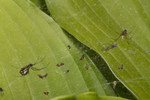 |
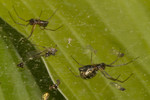 |
 |
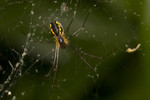 |
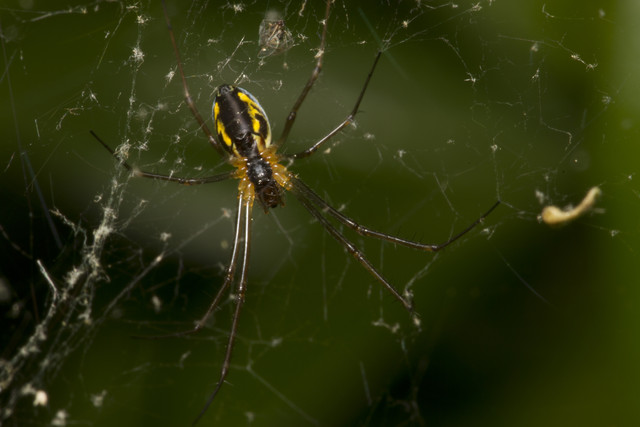 | |||
 |
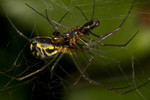 |
 |
 |
Technical Data: Canon EOS 7D, Canon EF 100mm f/2.8L Macro IS USM, 1/160, 1/200, or 1/250 sec at f/16. Canon Speedlight 580EX II flash in auto mode and wireless control. Image Stabilization on. ISO 160. RAW processing in Adobe Camera Raw. Last three photos with Kenko Teleplus PRO 300 "DG" AF 2x Teleconverter.
So, the top row of photos all basically just show the spiders. The female is the slightly larger one with the yellow stripes along her abdomen. In the first couple shots, you can see just how effective they've been at trapping various bugs, and can see how they are coexisting with each other in the same web peacefully.
The bottom row of photos all depict their mating behavior. The male would drum on the females abdomen with his pedipalps (the short "arms" by his head - in this species they look like they have large brown boxing gloves on them). After that he would either inflate an organ there or secrete a yellowish liquid (I'm honestly not sure which it was), and then pass a sperm packet to the female (the organ would deflate or the yellowish liquid would be absorbed into the female). This went on literally for hours. I stopped back repeatedly hoping to get a photo of the final act... which is the female eating the male after they have finished mating. Unfortunately, I never managed to get that shot.
But I thought capturing the mating behavior of such a tiny little spider was kind of interesting. Since then, I've noticed at least three other pairs of spiders mating as well, and every time I do, the next morning that web is inhabited by only the female. The poor guys have it rough! Then again, the females will hold on to those sperm packets for some amount of time until they're ready to lay eggs, and then fertilize probably several hundred eggs at once. Perhaps having several hundred babies to contend with is why the males willingly let themselves be eaten after mating...
Sorry if the spider photos gave you the heebie-jeebies, but thanks for stopping by for my 200th post. Leave me a comment and let me know what you think of these shots. And I promise I'll share a nice calm flower photo with no adult content tomorrow...
- Bill
Flashy Jumping Spider
ktuli — Fri, 04/29/2011 - 19:42
I found this little guy at work today. No lie! He was crawling along my desk, so I scooped him up in a small plastic container I keep at work for just these purposes (yeah, I know - I'm a little bit weird like that). I brought him home, and tried setting up to get some shots of him. He doesn't like to sit still, so I only managed two decent ones before I decided to let him go back to sleep for the night. I might try a couple more tomorrow and then release him when it is nice and warm outside.
Technical Data: Canon EOS 7D, Canon EF 100mm f/2.8L Macro IS USM, 1/200 sec at f/16. Canon Speedlight 580EX II flash in auto mode and wireless control. Image Stabilization on. ISO 400. RAW processing and cropped in Adobe Camera Raw.
Technical Data: Canon EOS 7D, Canon EF 100mm f/2.8L Macro IS USM, 1/200 sec at f/16. Canon Speedlight 580EX II flash in auto mode and wireless control. Image Stabilization on. ISO 400. RAW processing and cropped in Adobe Camera Raw.
Both shots are just a tad off on their focus. The first one would have done better to be focused on his face, but unfortunately, I was not expecting him to twist towards me like that and was focused more on his back. Like I said - he just didn't want to sit still.
Oh well, I'll keep trying.
- Bill
Kanawha State Forest Spider: Redux
ktuli — Mon, 10/04/2010 - 16:01
If you have been following along, you know that I am not big on photoshopping my photos very much. Partially this is because I'm a purist and would rather get the "perfect" shot right with the camera, partially because I generally feel I do a bad job when trying to use Photoshop, and partially because I really hate poorly and obviously photoshopped images.
But the other day, I was able to take one of my all-time favorite photos I've ever taken and make it better with several small adjustments with Photoshop Elements.
The photo in question is one in a set of photos taken of a cool looking spider we had found in Kanawha State Forest near Charleston, WV. I debated saving this modified version to discuss sometime in the future when I needed a post to get me going, but between the good results I got and really liking the nice mouseover trick I found recently, I just couldn't wait.
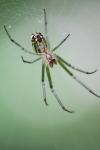 |
Original Image | 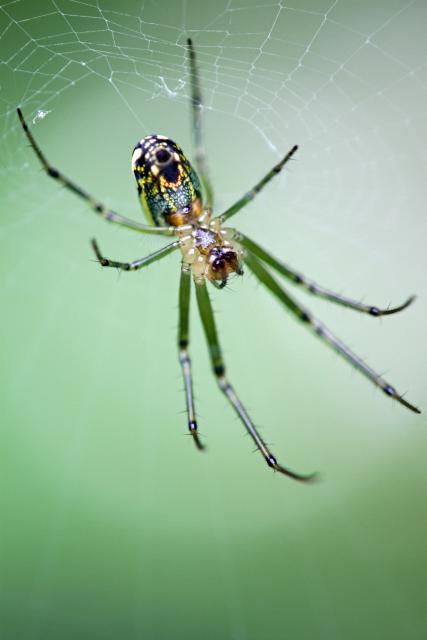 |
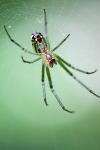 |
Auto Adjusted | |
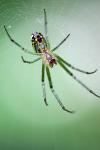 |
Spot Heal tool on thorax to remove hotspot. Darken highlights 50% on abdomen. | |
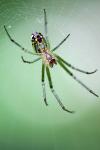 |
Clone Stamp tool used to touch up leg that touched right edge of frame. |
As you can see, the adjustments are very minor, and if you didn't know they happened, you probably couldn't even tell. Heck - some of them, you'll probably have to look very closely to see the difference between the two images when they're displayed even like they are here (I find myself sliding my mouse back and forth over the thumbnails to have the change flip back and forth on the larger image). But to me, that is a successfully photoshopped image - one where you can't even tell that photoshop was used.
I am submitting this photo to an upcoming Photographic Section digital projected image competition, so we'll see how my minor adjustments do. I with I could submit both photos and see which one scored better to see whether the edits were worthwhile.
Regardless, I managed to take one of my favorite photos and make it that much better. I'm glad I didn't have this one printed and framed yet, because it definitely would have to be redone with this new version!
- Bill
Kanawha State Forest Spider (part 2)
ktuli — Fri, 06/04/2010 - 22:13
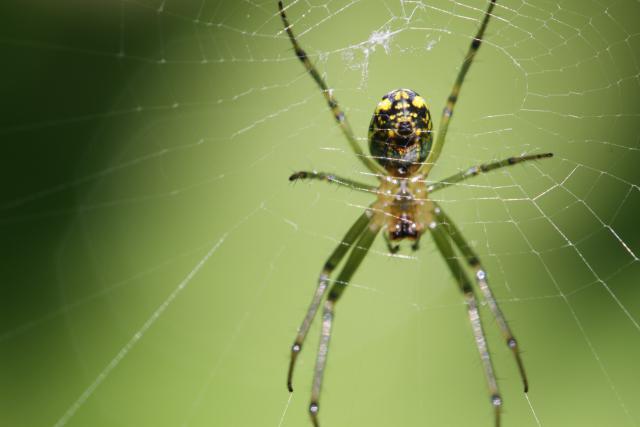
Technical Data: Canon EOS 7D, Tamron 180mm f/3.5 Di SP LD 1:1 Macro, 1/170 sec at f/7. ISO 200. Dolica AX620B100 tripod. No post production. Kanawha State Forest, Charleston, WV.
Spider Strike Cropping
ktuli — Tue, 06/01/2010 - 20:23
So while we're on the subject of different framing, let's talk a bit about cropping to give yourself more framing options.
This is something I'm quite often guilty of not paying attention to, and unfortunately my error is usually in the sense that I crop too tightly in my original photograph (often cutting an element off) and not allowing myself room for software cropping later.
For this photo of a spider pouncing on its prey, I managed to leave myself room to crop...

Technical Data: Canon EOS 7D, Tamron 180mm f/3.5 Di SP LD 1:1 Macro, 1/21 sec at f/8. ISO 200. Dolica AX620B100 tripod. No post production. Kanawha State Forest, Charleston, WV.
After reviewing at home on the computer, I felt the image lacked impact with the spider being small within the frame. So I fired up Photoshop to see what cropping possibilities there were...

I am not entirely sure how I feel about the stem of grass in the vertical crop, but I didn't want to remove it and modify the image much for this discussion. However, the grass works just fine in the horizontal crop.
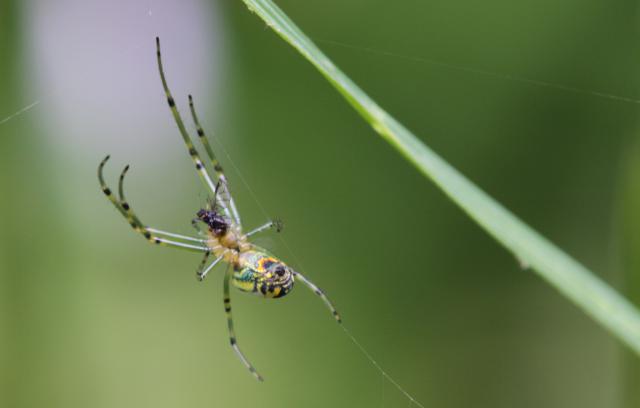
In general, I'm not really one to do much post production editing to my photos. I don't know if it is a perfectionism kind of thing, or just a dislike for edited photos (though one can argue whether simple cropping is much in the way of editing).
However, if I continue to find examples like this that open multiple possibilities from a single exposure, I may start turning that opinion around.
- Bill
PS: For a better view of this spider, check out my current favorite spider photo
Kanawha State Forest Spider (part 1)
ktuli — Wed, 05/26/2010 - 20:56
If you haven't read the first post from our Kanawha State Forest trip, check it out here.
This is the first of several shots of the same species of spider (I haven't been able to identify it yet) I took while wandering around the Kanawha State Forest outside Charleston, WV.
We saw this spider on our first day there, and I got several shots I liked, but still went back for more on Sunday. I found the same three spiders in the same locations and took a bunch more shots. Specifically one of the things I went back for was a vertically oriented photograph, and this is probably my favorite one from the set.
Technical Data: Canon EOS 7D, Tamron 180mm f/3.5 Di SP LD 1:1 Macro, 1/130 sec at f/3.5. ISO 200. Dolica AX620B100 tripod. No post production. Kanawha State Forest, Charleston, WV.
Why This Photo: I really wanted a vertical shot of this spider, so I specifically went back to capture an image like this.
What Works: Focus is pretty sharp. I like the diagonal orientation of the spider within this vertical shot. And though I didn't specifically try for it, the background produces a nice frame around the spider within the frame of the shot, and very faintly keeps the web in the shot towards the bottom while also making the spider appear to be floating in mid-air.
What Doesn't Work: Unfortunately, to achieve the focus I did, I had to use a wide aperture which causes the spider's legs to not be in focus while the body is in focus. And the one tip of the leg on the right side of the frame just barely breaks the right of the edge of the image.
I have some more photos of these spiders to share later, but drop me a comment and let me know what you think of this one.
Thanks for stopping by.
- Bill
Crab Spider (part 3)
ktuli — Mon, 04/19/2010 - 20:26
So we're closing in on the end of the available photos from this crab spider. Towards the end of the shoot, this little guy definitely let me know he was getting tired of me.
That is definitely something you need to be conscientious of when working with any kind of wildlife photography. Your subject will definitely let you know when you need to back off. Ideally, you want to be done with your photos well before that time comes - both for the health of your subject as well as for the natural behavior to be captured in your images.
It is a little tougher to identify those warning signals with small insects and spiders. This is definitely one, though.
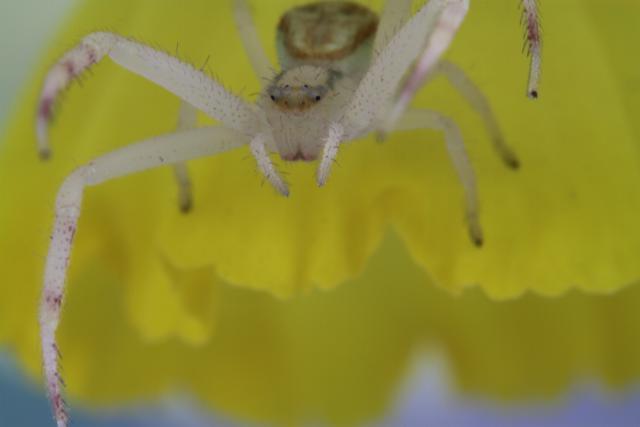
Technical Data: Canon EOS 7D, Tamron 180mm f/3.5 Di SP LD 1:1 Macro with Kenko Teleplus PRO 300 "DG" AF 2x Teleconverter for effective 360mm with 68mm in extension tubes. 1/2 sec at f/9.1 and exposure compensation +1/3 stop. ISO 200. No post production.
Why This Photo: I was just working the subject as much as I could before having to pack it in. At this point, almost any motion caused him to rear up and posture aggressively (earlier in the shoot, it took dramatic motions or very loud noises like my dog barking). At this point, he was charging to the edge of the flower and waving his front limbs around like crazy. I had him framed and set for what I thought would be a great shot, and as I pressed the shutter release and started the timer, he waves his limbs around again, and I just had to get whatever posture he ended up in when the timer ended.
What Works: Focus is sharp, and I like the overall exposure. I like how the edge of the flower was visible in this shot - so many of the shots in this set were so zoomed in that it wasn't always apparent that this was on a flower.
What Doesn't Work: The original framing had all parts of the spider inside the shot, but after he decided to flail about wildly, that wasn't the case for the final shot. I could have not framed the original shot so tightly, but then I would be sacrificing some of the magnification.
One other thing I was going for with this shot was to capture the nice greenish color on the abdomen of the spider. It really was very beautiful. You can catch a hint of it here, but unfortunately, I don't think I did such a good job of capturing that. I didn't manage to get it in any of the photos in this set.
What do you think?
- Bill
Poll: Crab Spider (part 2)
ktuli — Wed, 04/14/2010 - 19:02
If you haven't read part 1 yet, definitely check it out.
I've said this before here, but when you find a subject worth shooting, take your time and work with the subject. I kept over thirty exposures (and took probably twice that many but deleted the completely worthless ones) from a span of over two hours of working with this spider.
Definitely work your subject.
With that in mind, I kept trying different exposure levels. Here are four different exposures - take a look and vote below for your favorite. Despite the great variance in the look of these photos, these are straight out of the camera with no post production.

Version 1: 1/5 sec at f/9.1 with pop-up flash. IMG_0998
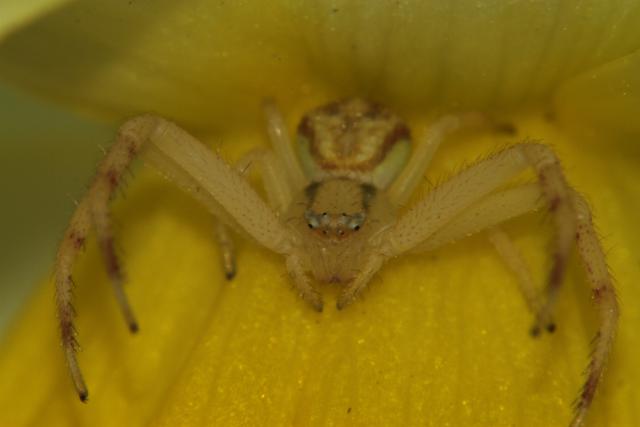
Version 2: 1/10 sec at f/9.1 with pop-up flash and exposure compensation -1 stop. IMG_0999
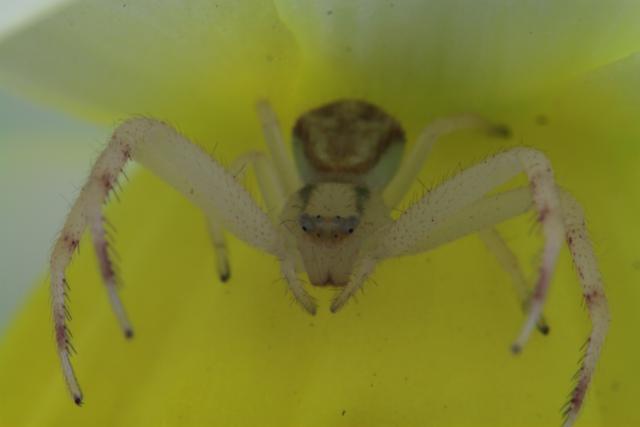
Version 3: 1/3 sec at f/9.1 with no flash and exposure compensation -1/3 stop. IMG_1000
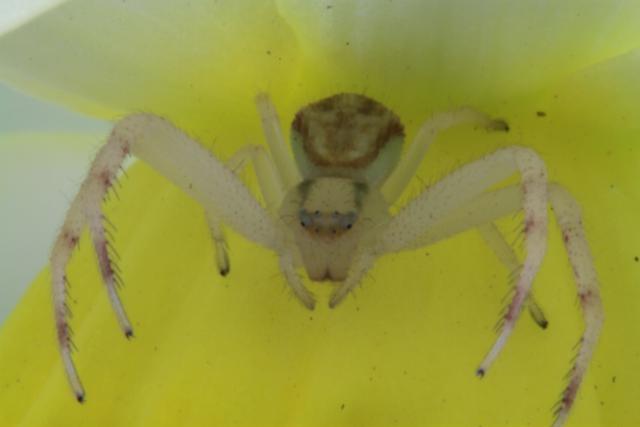
Version 4: 4 sec at f/25.8 with no flash. IMG_1001
Pretty different, huh? If you use tabs in your browser, I recommend opening each image in a different tab (usually control+clicking the link) and switching between the tabs to see the distinct difference between the images (scrolling through them sometimes makes it tougher to compare.
General Technical Data:Canon EOS 7D, Tamron 180mm f/3.5 Di SP LD 1:1 Macro with Kenko Teleplus PRO 300 "DG" AF 2x Teleconverter for effective 360mm with 68mm in extension tubes. ISO 200. No post production.
One of these will definitely be submitted to a couple upcoming contests. I just need to figure out which one I like best.
What do you think? Vote below, and then leave a comment and let me know why you chose the version you did.
- Bill
Crab Spider (part 1)
ktuli — Tue, 04/13/2010 - 20:36
I've seen photos of crab spiders before, and I've always thought they were awesome spiders. When I found one in our own garden, I was amazed. I spent the better portion of the evening photographing it.
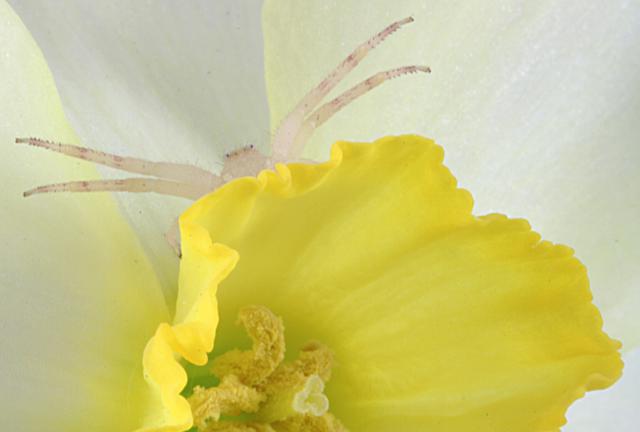
Technical Data: Canon EOS 7D, Tamron 180mm f/3.5 Di SP LD 1:1 Macro with Kenko Teleplus PRO 300 "DG" AF 2x Teleconverter for effective 360mm. 1 second at f/28.1. ISO 200. Post Production: Sharpen 100% 15 pixels, cropped (original).
Why This Photo: This is the first crab spider I've seen, so I took as many photos as I could. It was fairly aggressive and would posture like this whenever loud noises or quick motions happened. I wanted to try and capture that aggressive posturing.
What Works: I did some of the things I've been meaning to try and keep in mind with my macro work. The kind of stuff I did to try and make this photo better include:
- Used a tripod
- Smaller aperture for greater depth of field
- Timer delay (since I still don't have a remote trigger)
- Live View with zoom for better focusing
- Generous framing to allow for cropping if necessary
What Didn't Work: I wasn't thrilled with the framing, but since I left enough room, I was able to crop it down to something I liked more. The image was a bit out of focus, but I was able to sharpen it a little in Photoshop. I keep debating the exposure levels, feeling that the image is a bit blown out, but haven't been able to adjust the levels in Photoshop to my liking - though the cropping removed some of the problem by removing some of the extra areas of white flower pedals.
Working on these photos helped me to feel like I've come along way and have started to put some of the things I've learned into practice. At the same time, they's showed me how much more I have to learn.
What do you think? How did I do with this very special subject to shoot?
- Bill
Here Come the Spiders!
ktuli — Thu, 03/11/2010 - 21:58
This is one of my favorite photos. I've submitted this image to multiple compeitions. Most recently, it has been accepted into the The Photographic Section's 2010 Annual Photo Salon for its traveling gallery, and for final judging in George W. Glennie Memorial Nature Salon 2010.
I've been waiting to share this photo since I didn't want to use up all my best photos too quickly. But I figure now is a good time...

Technical Data: Canon EOS Digital Rebel XT, Tamron 180mm f/3.5 Di SP LD 1:1 Macro, 1/100 sec at f/5.6. ISO 400. No post production. McConnell's Mill State Park, Lawrence County, PA.
Why This Photo: I love macro photography. Given the chance, I'll shoot something tiny like this little jumping spider over most other photography opportunities nine times out of ten. The story of this is kind of amusing and I'll give more of it a bit further down.
What Works: Focus is dead on right on the spider's eyes. The catchlight in the spider's eyes is a nice effect. The composition, including the slight tilt work well also.
What Doesn't Work: The depth of field could have been a little deeper and focus could be a tad sharper.
This shot was taken hand-held. I don't think I had a tripod with me that day that would have been able to support the camera with my Tamron macro lens attached. Besides, this spider was crawling around on a wooden railing right at the mill at McConnell's Mill State Park.
Remember what I said about preferring macro over almost every other style of photography? I was sitting on the ground by the railing overlooking Slippery Rock Creek Gorge, right next to the gristmill, and just upstream from a very picturesque covered bridge. There were plenty of people coming and going on the overlook, all of them quickly snapping shots of the stream, mill, and/or bridge and then wandering back off.
Most everyone either ignored me or just gave me a glancing confused look wondering what in the world I could have been taking photos of. Only one person asked what I was so interested in, and thought it was pretty amusing that I would be focusing on such a tiny little spider.
With the weather warming up, I'm looking forward to things like spiders appearing again and giving me something to shoot. I saw a tiny tiny spider on my walk home from the T yesterday, and I was so excited by that.
I know - I'm weird. But either way, what do you think of the photo? Leave me a message and let me know.
- Bill

